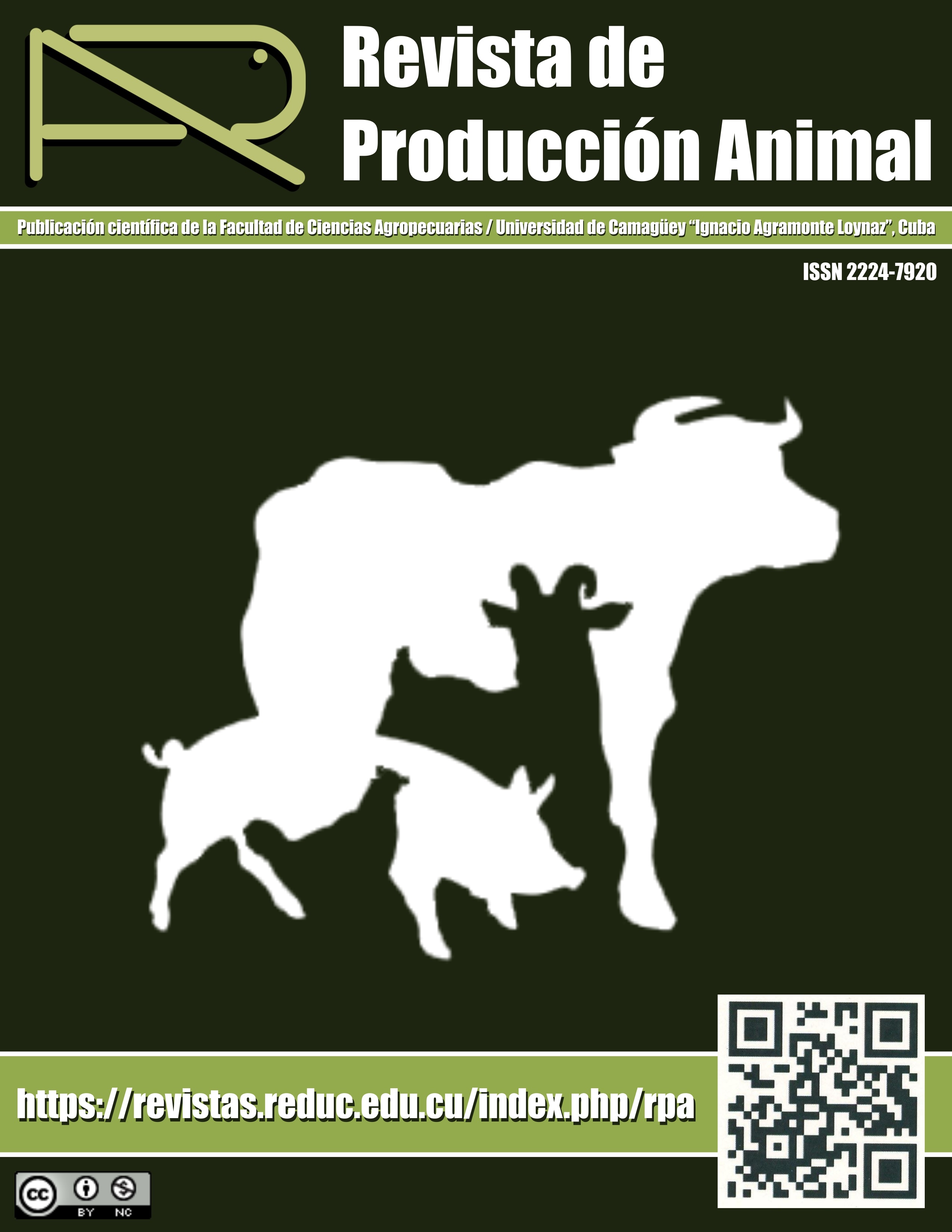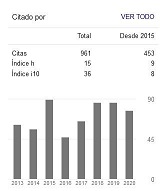Agonistas del receptor de hidrocarburos de arilo como contaminantes en alimentos para la producción animal
Resumen
Antecedentes: La salud de los humanos y animales está estrechamente vinculada. Muchos alimentos pueden contener materiales tóxicos y la mayoría de los productos químicos tienen un rango de uso seguro, pero en dosis altas pueden ser dañinos. Objetivo. Destacar la importancia del control ambiental para la minimización de los riesgos de intoxicación por dioxinas y sus congéneres en la producción de alimentos para los animales de granja y para el hombre.
Desarrollo: Las Dioxinas y PCB’s dioxinas (dibenzoparadioxinaspolicloradas o PCDD son 75 sustancias congéneres), furanos (dibenzofuranospoliclorados son 135 congéneres). Solo algunas de las sustancias de cada grupo son tóxicas. El receptor de hidrocarburo de arilo (AHR), que también se conoce como receptor de dioxinas, está presente en numerosas especies animales, incluidos humanos y activa la expresión génica de una manera dependiente de ligando. El prototipo de ligando 2,3,7,8-tetraclorodibenzo-p-dioxina (TCDD), es una dioxina arquetípica conocida como uno de los congéneres más potentes. La presencia de dioxinas en los tejidos animales, deriva de su alimentación. Su presencia en ciertos niveles puede provocar cáncer; alteraciones del sistema inmune, del sistema nervioso; lesiones hepáticas; y esterilidad.
Conclusiones: Queda evidenciada la importancia del control ambiental para la minimización de los riesgos de intoxicación por dioxinas y sus congéneres en la producción de alimentos. Es necesario que las personas vinculadas a tales producciones conozcan más sobre estos compuestos y colaboren en la identificación de los posibles peligros y niveles de riesgo.
Palabras clave: ordeño, animales de granja, contaminación de alimentos, Dioxinas, Proteínas bHLH-PAS, Receptor de Hidrocarburo de Arilo (Fuente: MESH)
Descargas
Citas
Abdullah, A., Maged, M., Hairul-Islam M, I., Osama I, A., Maha, H., Manal, A., & Hamza, H. (2019). Activation of aryl hydrocarbon receptor signaling by a novel agonist ameliorates autoimmune encephalomyelitis. PloS one, 14(4), e0215981. https://doi.org/10.1371/journal.pone.0215981
Al-Ghezi, Z. Z., Singh, N., Mehrpouya-Bahrami, P., Busbee, P. B., Nagarkatti, M., & Nagarkatti, P. S. (2019). AhR activation by TCDD (2, 3, 7, 8-Tetrachlorodibenzo-p-dioxin) attenuates pertussis toxin-induced inflammatory responses by differential regulation of tregs and Th17 cells through specific targeting by microRNA. Frontiers in microbiology, 10, 2349. https://doi.org/10.3389/fmicb.2019.02349
Aranguren-Abadía, L., Donald, C. E., Eilertsen, M., Gharbi, N., Tronci, V., Sørhus, E., Mayer, P., Nilsen, T. O., Meier, S., Goksøyr, A., & Karlsen, O. A. (2020). Expression and localization of the aryl hydrocarbon receptors and cytochrome P450 1A during early development of Atlantic cod (Gadus morhua). Aquatic Toxicology, 226, 105558. https://doi.org/10.1016/j.aquatox.2020.105558
Avilla, M. N., Malecki, K. M., Hahn, M. E., Wilson, R. H., & Bradfield, C. A. (2020). The Ah receptor: Adaptive metabolism, ligand diversity, and the xenokine model. Chemical research in toxicology, 33(4), 860-879. https://doi.org/10.1021/acs.chemrestox.9b00476
Badui, S. (2006). Química de los Alimentos. Cuarta edición. México DF. https://www.academia.edu/31337237/Qu%C3%ADmica_de_los_Alimentos_4_Edici%C3%B3n_Salvador_Badui_Dergal
Rodríguez, F. C. (2001). Introducción a la alimentación y racionamiento animal. http://area.us.es/gprodanim/Racionamiento/Introd%20Racionamiento%2006-07.pdf
Corrada, D., Denison, M. S., & Bonati, L. (2017). Structural modeling of the AhR: ARNT complex in the bHLH-PASA-PASB region elucidates the key determinants of dimerization. Molecular BioSystems, 13(5), 981-990. https://pubs.rsc.org/en/content/articlelanding/2017/mb/c7mb00005g/unauth
Danjou, A. M. N., Coudon, T., Praud, D., Lévêque, E., Faure, E., Salizzoni, P., Romancer, M. L., Severi, G., Mancini, F. R., Leffondré, K., Dossus, L., & Fervers, B. (2019). Long-term airborne dioxin exposure and breast cancer risk in a case-control study nested within the French E3N prospective cohort. Environment international, 124, 236-248. https://doi.org/10.1016/j.envint.2019.01.001
Dai, Q., Xu, X., Eskenazi, B., Asante, K. A., Chen, A., Fobil, J., Bergman, Å., Brennan, L., Sly, P. D., Nnorom, I. C., Pascale, A., Wang, Q., Zeng, Z., Landrigan, P. J., Drisse, M. N. B., & Huo, X. (2020). Severe dioxin-like compound (DLC) contamination in e-waste recycling areas: An under-recognized threat to local health. Environment international, 139, 105731. https://doi.org/10.1016/j.envint.2020.105731
DeMan, J. M., Finley, J. W., Hurst, W. J., & Lee, C. Y. (2018). Principles of food chemistry. Food Science Text Series. Fourth Edition. Gaithersburg: Aspen Publishers. https://b-ok.lat/book/3494375/984072
EFSA Panel on Contaminants in the Food Chain (CONTAM), Knutsen, H. K., Alexander, J., Barregård, L., Bignami, M., Brüschweiler, B., Ceccatelli, S., Cottrill, B., Dinovi, M., Edler, L., Grasl-Kraupp, B., Hogstrand, C., Nebbia, C. S., Oswald, I. P., Petersen, A., Rose, M., Roudot, A. C., Schwerdtle, T., Vleminckx, C., Vollmer, G., … & Hoogenboom, L. (2018). Risk for animal and human health related to the presence of dioxins and dioxin‐like PCBs in feed and food. Efsa Journal, 16(11), e05333. https://doi.org/10.2903/j.efsa.2018.5333
Esser, C. (2021). Trajectory Shifts in Interdisciplinary Research of the Aryl Hydrocarbon Receptor—A Personal Perspective on Thymus and Skin. International journal of molecular sciences, 22(4), 1844. https://doi.org/10.3390/ijms22041844
Falandysz, J., Smith, F., & Fernandes, A. R. (2020). Polybrominated dibenzo-p-dioxins (PBDDs) and-dibenzofurans (PBDFs) in cod (Gadus morhua) liver-derived products from 1972 to 2017. Science of The Total Environment, 722, 137840. https://doi.org/10.1016/j.scitotenv.2020.137840
FAO & IFIF. (2014). Buenas prácticas para la industria de piensos-Implementación del Código de Prácticas Sobre Buena Alimentación Animal. https://www.fao.org/3/i1379s/i1379s00.htm
FAO & OMS. (2018). Código de prácticas para prevenir y reducir la contaminación en los alimentos y piensos por Dioxinas y Bifeniles Policlorados (BPC) análogos a las Dioxinas. https://www.fao.org/faowhocodexalimentarius/shproxy/ru/?lnk=1&url=https%253A%252F%252Fworkspace.fao.org%252Fsites%252Fcodex%252FStandars%252FCXC%2B62-2006%252FCXC_062s.pdf
FAO. (2021). Una Salud. https://www.fao.org/one-health/es/
Damodaran, S., & Parkin, K. (2017). Fennema’s food chemistry. Fifth edition. CRC Press. https://www.routledge.com/FennemasFoodChemistry/DamodaranParkin/p/book/9781482208122
Fribourgh, J. L., & Partch, C. L. (2017). Assembly and function of bHLH-PAS complexes. Proceedings of the National Academy of Sciences, 114(21), 5330-5332. https://doi.org/10.1073/pnas.1705408114
Furue, M., Ishii, Y., Tsukimori, K., & Tsuji, G. (2021). Aryl Hydrocarbon Receptor and Dioxin-Related Health Hazards—Lessons from Yusho. International journal of molecular sciences, 22(2), 708. https://doi.org/10.3390/ijms22020708
Goya-Jorge, E., Jorge Rodríguez, M. E., Veitía, M. S. I., & Giner, R. M. (2021). Plant Occurring Flavonoids as Modulators of the Aryl Hydrocarbon Receptor. Molecules, 26(8), 2315. https://doi.org/10.3390/molecules26082315
Guardo, M. (2018). El abordaje de" Una Salud", más esencial que nunca. Revista Peruana de Medicina Experimental y Salud Pública, 35, 558-560. https://doi.org/10.17843/rpmesp.2018.354.4144
Haidar, R., Henkler, F., Kugler, J., Rosin, A., Genkinger, D., Laux, P., & Luch, A. (2021). The role of DNA-binding and ARNT dimerization on the nucleo-cytoplasmic translocation of the aryl hydrocarbon receptor. Scientific reports, 11(1), 1-11. https://doi.org/10.1038/s41598-021-97507-w
Hattori, Y., Takeda, T., Nakamura, A., Nishida, K., Shioji, Y., Fukumitsu, H., Yamada, H., & Ishii, Y. (2018). The aryl hydrocarbon receptor is indispensable for dioxin-induced defects in sexually-dimorphic behaviors due to the reduction in fetal steroidogenesis of the pituitary-gonadal axis in rats. Biochemical pharmacology, 154, 213-221. https://doi.org/10.1016/j.bcp.2018.05.008
Kawajiri, K., & Fujii-Kuriyama, Y. (2017). The aryl hydrocarbon receptor: a multifunctional chemical sensor for host defense and homeostatic maintenance. Experimental animals, 66(2), 75-89. https://doi.org/10.1538/expanim.16-0092
Khazaal, A. Q., Jaeger, C. D., Bottum, K. M., & Tischkau, S. A. (2018). Environmental factors act through aryl hydrocarbon receptor activation and circadian rhythm disruption to regulate energy metabolism. Journal of Receptor, Ligand and Channel Research, 10, 13. https://pdfs.semanticscholar.org/fcd2/7daa9f342d56c28f3f2bd-37d438832c62954.pdf
Kou, Z., & Dai, W. (2021). Aryl hydrocarbon receptor: Its roles in physiology. Biochemical Pharmacology, 185, 114428. https://doi.org/10.1016/j.bcp.2021.114428
Larigot, L., Juricek, L., Dairou, J., & Coumoul, X. (2018). AhR signaling pathways and regulatory functions. Biochimie open, 7, 1-9. https://doi.org/10.1016/j.biopen.2018.05.001
Madeira, F., Park, Y. M., Lee, J., Buso, N., Gur, T., Madhusoodanan, N., Basutkar, P., Tivey, A. R. N., Potter, S. C., Finn, R. D., & Lopez, R. (2019). The EMBL-EBI search and sequence analysis tools APIs in 2019. Nucleic acids research, 47(W1), W636-W641. https://doi.org/10.1093/nar/gkz268
Mahringer, A., Bernd, A., Miller, D. S., & Fricker, G. (2019). Aryl hydrocarbon receptor ligands increase ABC transporter activity and protein expression in killifish (Fundulus heteroclitus) renal proximal tubules. Biological chemistry, 400(10), 1335-1345. https://doi.org/10.1515/hsz-2018-0425
Mengoni, M., Braun, A. D., Gaffal, E., & Tüting, T. (2020). The aryl hydrocarbon receptor promotes inflammation‐induced dedifferentiation and systemic metastatic spread of melanoma cells. International Journal of Cancer, 147(10), 2902-2913. https://doi.org/10.1002/ijc.33252
OPS/OMS. (2021). Día Mundial de la Inocuidad de los alimentos. https://www.paho.org/es/campanas/dia-mundial-inocuidad-alimentos-2021
Panda, R., Cleave, A. S. S., & Suresh, P. K. (2012). In silico predictive studies of mAHR congener binding using homology modelling and molecular docking. Toxicology and industrial health, 30(8), 765-776. https://doi.org/10.1177/0748233712463774
Jiménez, M. R., & Kuhn, G. R. (2009). Toxicología fundamental. Ediciones Díaz de Santos. https://www.editdiazdesantos.com/wwwdat/pdf/9788479788988.pdf
Roztocil, E., Hammond, C. L., Gonzalez, M. O., Feldon, S. E., & Woeller, C. F. (2020). The aryl hydrocarbon receptor pathway controls matrix metalloproteinase-1 and collagen levels in human orbital fibroblasts. Scientific reports, 10(1), 1-16. https://doi.org/10.1038/s41598-020-65414-1
Sadik, A., Patterson, L. F. S., Öztürk, S., Mohapatra, S. R., Panitz, V., Secker, P. F., Pfänder, P., Loth, S., Salem, H., Prentzell, M. T., Berdel, B., Iskar, M., Faessler, E., Reuter, F., Kirst, I., Kalter, V., Foerster, K. I., Jäger, E., & Opitz, C. A. (2020). IL4I1 is a metabolic immune checkpoint that activates the AHR and promotes tumor progression. Cell, 182(5), 1252-1270. https://doi.org/10.1016/j.cell.2020.07.038
Schulte, K. W., Green, E., Wilz, A., Platten, M., & Daumke, O. (2017). Structural basis for aryl hydrocarbon receptor-mediated gene activation. Structure, 25(7), 1025-1033. https://doi.org/10.1016/j.str.2017.05.008
Kim, S. Y., Kim, K. W., Lee, S. M., Lee, D. H., Park, S., Son, B. S., & Park, M. K. (2020). Overexpression of the Aryl Hydrocarbon Receptor (Ahr) Mediates an Oxidative Stress Response following Injection of Fine Particulate Matter in the Temporal Cortex. Oxidative medicine and cellular longevity, 2020. https://doi.org/10.1155/2020/6879738
Soto, S. (2021). La salud humana y la sanidad animal son interdependientes y están vinculadas a los ecosistemas en los cuales coexisten. https://www.isglobal.org/healthisglobal/-/custom-blog-portlet/one-health-una-sola-salud-o-como-lograr-a-la-vez-una-salud-optima-para-las-personas-los-animales-y-nuestro-planeta/90586/0
Szöllősi, D., Erdei, Á., Gyimesi, G., Magyar, C., & Hegedűs, T. (2016). Access path to the ligand binding pocket may play a role in xenobiotics selection by AhR. PloS one, 11(1), e0146066. https://doi.org/10.1371/journal.pone.0146066
UniProt: the universal protein knowledgebase in 2021. (2021). Nucleic Acids Research. 49(D1), D480-D489. https://doi.org/10.1093/nar/gkaa1100
Torti, M. F., Giovannoni, F., Quintana, F. J., & García, C. C. (2021). The Aryl Hydrocarbon Receptor as a Modulator of Anti-viral Immunity. Frontiers in Immunology, 12, 440. https://doi.org/10.3389/fimmu.2021.624293
Tuomisto, J., Airaksinen, R., Pekkanen, J., Tukiainen, E., Kiviranta, H., & Tuomisto, J. T. (2017). Comparison of questionnaire data and analyzed dioxin concentrations as a measure of exposure in soft-tissue sarcoma studies. Toxicology letters, 270, 8-11. https://doi.org/10.1016/j.toxlet.2017.02.011
Weber, R., Herold, C., Hollert, H., Kamphues, J., Ungemach, L., Blepp, M., & Ballschmiter, K. (2018). Life cycle of PCBs and contamination of the environment and of food products from animal origin. Environmental Science and Pollution Research, 25(17), 16325-16343. https://doi.org/10.1007/s11356-018-1811-y
Weber, R., Herold, C., Hollert, H., Kamphues, J., Blepp, M., & Ballschmiter, K. (2018). Reviewing the relevance of dioxin and PCB sources for food from animal origin and the need for their inventory, control and management. Environmental Sciences Europe, 30(1), 1-42. https://doi.org/10.1186/s12302-018-0166-9
Wong, D. W. S. (2018). Mechanism and Theory in Food Chemistry, Second Edition. https://pdfcoffee.com/mechanism-and-theory-in-food-chemistrypdf-4-pdf-free.html
Wu, D., & Rastinejad, F. (2017). Structural characterization of mammalian bHLH-PAS transcription factors. Current opinion in structural biology, 43, 1-9. https://doi.org/10.1016/j.sbi.2016.09.011
Zhai, Y., Amadou, A., Mercier, C., Praud, D., Faure, E., Iwaz, J., Severi, G., Mancini, F. R., Coudon, T., Fervers, B., & Roy, P. (2021). The impact of left truncation of exposure in environmental case–control studies: evidence from breast cancer risk associated with airborne dioxin. European Journal of Epidemiology, 1-15. https://doi.org/10.1007/s10654-021-00776-y
Zhou, Y., & Liu, J. (2018). Emissions, environmental levels, sources, formation pathways, and analysis of polybrominated dibenzo-p-dioxins and dibenzofurans: a review. Environmental Science and Pollution Research, 25(33), 33082-33102. https://doi.org/10.1007/s11356-018-3307-1
Derechos de autor 2022 Revista de Producción Animal

Esta obra está bajo licencia internacional Creative Commons Reconocimiento-NoComercial 4.0.
Los autores de los artículos publicados en RPA retienen los derechos de autor de su trabajo, de marca y patente, y también sobre cualquier proceso o procedimiento descrito en el artículo, así como a compartir, copiar, distribuir, ejecutar y comunicar públicamente el artículo publicado en la RPA o cualquier parte de aquel siempre que indiquen la fuente de publicación (autores del trabajo, revista, volumen, número y fecha), pero están de acuerdo en que la revista publique los trabajos bajo una licencia Creative Commons.
![]() Licencia Attribution-NonCommercial 4.0 International (CC BY-NC 4.0)
Licencia Attribution-NonCommercial 4.0 International (CC BY-NC 4.0)






































